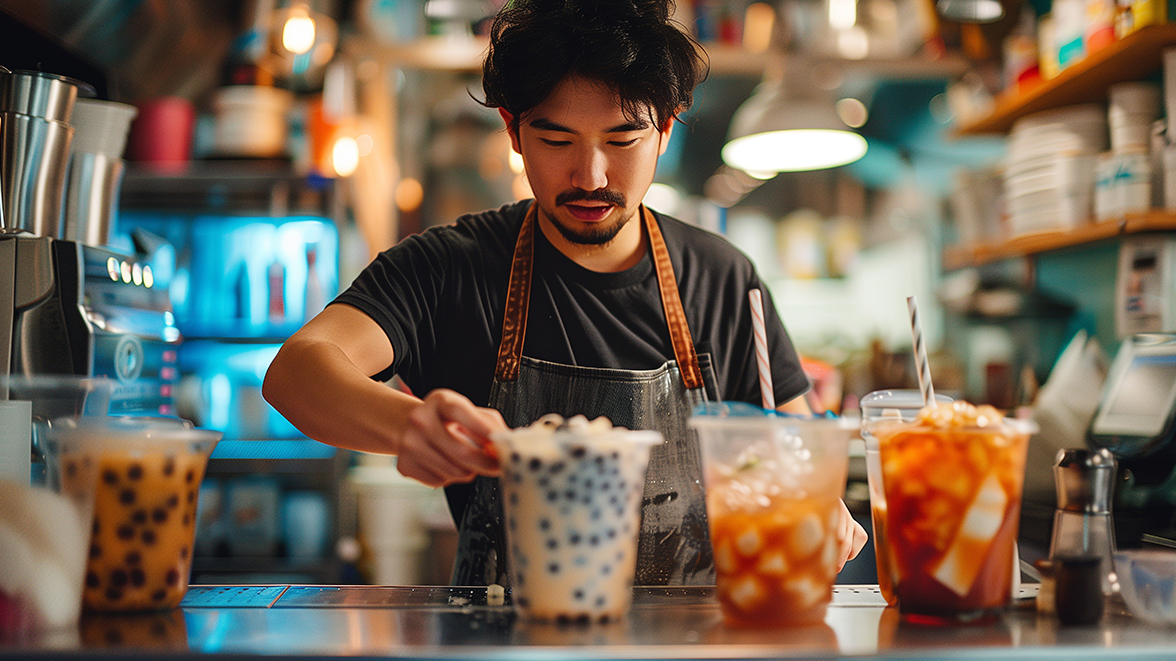
Opening a Boba Tea Shop in 2025: Complete Guide to Startup Success (and the Tech You Can’t Afford to Ignore)
Boba tea (also known as bubble tea) has gone from a niche Taiwanese treat to a global phenomenon—and its growth shows no signs of slowing down. Consequently, the US bubble tea market is estimated to grow at an impressive CAGR of 9.5% from 2024 to 2030.
If you are a restaurateur planning to open a boba tea shop, this might be the best time. However, to counter the growing competition, you must plan and strategize well before diving into the process of opening a boba tea shop.
Let’s check out some steps and parameters that will help you open a boba tea store successfully.
Nail Your Concept and Brand Foundation
When opening a boba tea shop, you must visualize the concept and brand identity before finding a storefront and ordering tapioca pearls.
Research Local Tastes vs. National Trends
Young people consume boba tea in a variety of flavors, including classic milk tea, brown sugar milk tea, classic black tea, taro milk tea, and Thai milk tea. Likewise, they experiment with blends like fruit-flavored tea, honeydew milk tea, coffee-flavored tea, and chocolate-flavored tea. Hence, you must include the right flavors and blends in your boba tea shop menu by conducting an online poll. Moreover, you should research the flavors and blends that help your competitors attract more customers.
Craft Your USP
Before opening the boba tea shop, you must think of a unique selling point (USP) that will differentiate from the competitors. For instance, you can stand out from the crowd by twisting or blending flavors. You must also make customers remember the experience by implementing sustainability best practices, offering discounts, and partnering with local artists.
Do a Quick Reality Check
Often, entrepreneurs prioritize aesthetics over speed and consistency when opening a bubble tea shop. You should remember that customers will switch to competitors when the tea quality wavers or your staff takes more time to serve. Hence, you must improve customer experiences and foster customer loyalty by streamlining operational workflow, training employees regularly, and leveraging cutting-edge technologies.
Location, Layout & Licensing Essentials
Location Strategy: Foot Traffic vs. Rent
When selecting a location for your boba tea store, you must prefer high foot traffic areas like colleges, malls, office parks, and busy transit hubs. However, you should shortlist locations that do not require paying more than 10-15% of projected monthly sales as rent.
Shop Layout: Lean Footprint Design
The ideal size of your store should be 300-800 square feet. Based on the space, you should plan the layout with limited seating (2-3 tables), a high-efficiency counter, and a compact kitchen. You must save space by implementing an all-in-one restaurant management platform that features a robust POS system, allows customers to access digital menus, and supports QR code transactions.
Licensing & Compliance
When opening a boba tea shop, you will need essential permits like a business license, food handler certificates for staff, a health department permit, and a sign permit. Some of these permits require a physical inspection of the store. Moreover, some documentation requires you to apply 2-3 months before the opening date. Hence, you should consider buffer time for meeting compliance. It is also advisable to accelerate the process by working with a reputable licensing consultant.
Building Your Core Menu—Lean, Scalable & Profitable
Starter Menu
Your starter menu must balance core flavors and seasonals perfectly. It must include popular boba flavors like classic milk, brown sugar milk, Thai milk tea, honeydew milk tea, and mango green tea. At the same time, you must keep the menu dynamic to include and rotate seasonals like strawberry rose, pumpkin spice, and lychee jasmine regularly.
Ingredient Sourcing
Your choice of distributors and suppliers will directly impact the boba tea shop’s profitability and operational continuity. When comparing ingredient sourcing options, you should prioritize local distributors. Also, you must avoid disruptions by partnering with 2-3 distributors. At the same time, you must control costs by keeping in mind the ingredients’ quantity and their shelf life.
Price Points
You must set the average price point between $5 and 7$. However, you can increase the average order value by supporting multiple toppings, sizes, and customizations. It is always advisable to determine the price points based on the cost of goods sold (COGS), which must remain under 30-35% per drink.
Critical Hiring and Training Strategies
Staffing for Peak Periods
Before hiring staff for your boba tea shop, you must define their roles and responsibilities clearly. It is always important to ensure the presence of a manager/shift head along with a cashier and a barista during each shift. At the same time, you must boost customer experiences during peak hours by deploying part-timers and floaters.
Training Protocols
When strategizing how to open a boba tea shop, you must maintain recipe consistency and quick service. Hence, you must provide baristas with drink recipes and visual aids. Your employees need training to increase the average order value by suggesting combo deals, new flavors, and toppings. At the same time, you must boost employee efficiency and mitigate technology-related stress by implementing a restaurant tech platform with an image-first user interface (UI).
The #1 Mistake Most New Boba Tea Shop Owners Make: Frankenstack
Too many first-time boba tea shop owners piece together a “Frankenstack” of disconnected tools—one system for POS, another for scheduling, another for online orders, and spreadsheets for everything else. It feels cheaper at first, but the hidden costs add up fast: duplicate data entry, costly integrations, and constant headaches when systems don’t talk to each other. This patchwork approach drains time, money, and focus—the exact resources a new shop can’t afford to waste.
Piecing Together 3–5 Vendors
Coffee shop owners often manage their operations using standalone tech tools. For instance, they simplify payment processing using a POS system, while implementing different apps for workforce scheduling, inventory tracking, and payroll, creating data silos. The efficiency of employees is also impacted when they toggle between multiple tech tools during the same shift.
Real Cost of “One-Off” Add-Ons
When a boba tea shop owner integrates the restaurant management software with third-party add-ons, he or she has to incur high subscription and integration costs. The data silos created by these tools make managers waste time reconciling data and rectifying errors. On the other hand, owners find it challenging to get a unified view of sales, inventory, and labor. These third-party tools do not generate unified reports and share data-driven insights.
A solution to these integration issues is to opt for a restaurant management software that offers all-inclusive features, covering everything from POS and payroll to time tracking and a kitchen display system.
Tech Evaluation Checklist for Boba Shop Owners
The right integrated restaurant management platform will help your boba tea shop boost customer experiences, staff productivity, and revenue while curbing operating costs. But you must consider some essential features in the software as well as ask relevant questions to the vendor.
Must-Have Features
Offline Mode: Keeps transactions flowing to ensure no lost sales when the internet drops.
Real-Time Sync: Ensures all data—inventory, orders, staffing—is instantly updated across devices.
Intuitive UI: Fast training for staff with fewer mistakes and faster service during peak hours.
Nice to Have Features
Recipe Costing: Tracks profit margins per drink automatically without using multiple spreadsheets.
Multi-Location Support: Future-proofs your tea shop by facilitating expansion to multiple shops with centralized control.
Key Questions to Ask Your Vendor on Day One
- What happens if my Wi-Fi goes down during peak hours?
- Can your system track ingredient-level inventory in real time?
- How often do your systems update, and do I need to manage version control?
- Do you charge extra for features like loyalty and delivery integrations?
- How does your platform help me understand customer behavior and repeat visits?
- What support will my team get after launch - email only, live chat, phone?
Launch and Scale: From Day One to Multiple Locations
Before unlocking the door for customers, you must simulate a real-time operating day in advance. The dry run will boost your confidence by revealing hidden issues and mitigating confusion.
Pre-Opening Dry Run
Before opening the boba tea shop, you must define and assign roles of key staff like cashier, prep, barista, and runners. Based on their roles, employees will practice routine operations like order management, payment handling, and shift changes. At the same time, they must use your choice of restaurant management platform to perform these activities. After monitoring these activities, you can refine operations like order flow simulation, payment methods, ticket routing, and real-time inventory updates.
Week One Optimization
After opening the boba tea shop, you must make several changes by observing key activities. For instance, it is always important to measure order turnaround time, detect employee performance gaps, collect customer feedback, check customizations, and identify top and bottom sellers. This initial monitoring will help you boost customer satisfaction by making smart and early changes.
Scaling Playbook
As the number of transactions and customers increases, your boba startup will need more terminals, handhelds, and new sites. When you choose a flexible and scalable restaurant tech platform like NOVA, it becomes easier for you to accommodate emerging needs quickly.
.png)
Why Your Boba Tea Shop Needs a Unified Platform Like NOVA from Day One?
Running a boba tea shop is challenging enough—managing staff, controlling inventory, and keeping costs in check shouldn’t add to the stress. From day one, NOVA gives you an all-in-one unified platform that replaces the patchwork of separate tools many new owners struggle with. By having POS, scheduling, inventory, and customer loyalty built into one system, you save money on integrations, cut down on manual errors, and gain real-time insights into your margins. With NOVA, every part of your shop works in sync, helping you scale faster and avoid the hidden costs that drain most new businesses.
A Unified and Intuitive Dashboard
You need real-time insights into sales, inventory, labor, and customer engagement to increase revenue and foster customer loyalty. NOVA features a unified dashboard that lets you get real-time insights and monitor key metrics
Other Built-in Features You’ll Actually Use
POS System Built for Cafes
NOVA offers a robust POS system with a feature-rich restaurant management platform. The POS system for cafes enables customers to make payments using cash, cards, digital wallets, or QR codes. Also, your bubble tea shop can boost customer experiences by ensuring faster checkouts during peak hours.
Handheld Ordering
Servers can take orders at the customer’s table using NOVA’s handheld POS. Also, customers can order drinks directly by accessing the QR code menu through their smartphones. The multiple ordering options help your establishment increase throughput when cutting down queue time.
Real-Time Inventory Tracking
Your boba tea shop can boost customer satisfaction only by preventing “Sorry, we’re out” moments. NOVA makes it easier for you to prevent such moments by providing real-time usage data for tea leaves, pearls, cups, syrups, and other ingredients. At the same time, the auto alerts sent by this AI-native restaurant management platform help you order low-stock items on time.
Integrated Online Ordering & Delivery
You can integrate NOVA with leading online ordering and delivery platforms without incurring extra expenses. At the same time, you can boost customer experience by keeping the menu consistent across in-store, app, and delivery platforms in seconds.
Build Your Branded Webstore from Day One
In today’s market, a large share of boba sales comes from online orders and delivery apps. But relying solely on third-party platforms means paying high commissions and losing control of your customer data. With NOVA, you can launch your own branded restaurant webstore in minutes—fully integrated with your POS. This gives your customers a seamless way to order directly from you, helps you build stronger loyalty programs, and ensures that more of every dollar stays in your pocket.
Smarter Workforce Scheduling That Scales
Managing part-time staff and rotating shifts can quickly become one of the biggest headaches for a new shop owner. NOVA’s built-in workforce scheduling takes the guesswork out of staffing. You can forecast labor needs based on sales trends, assign shifts with just a few clicks, and give employees a mobile app to swap or claim shifts—reducing no-shows and last-minute chaos. The result: optimized labor costs, happier staff, and more consistent service for your customers.
Tailored Loyalty Programs
NOVA helps you convert walk-ins into regular weekly visits by running personalized restaurant loyalty programs. You can impress and retain customers by offering personalized rewards and incentives. Customers can track and redeem loyalty points effortlessly when making payments.
Conclusion
In the fast-moving world of boba tea, trends will change frequently. But your boba tea shop can increase revenue and attract customers by prioritizing operational excellence. You cannot boost operational efficiency using multiple tech tools that do not talk to each other. Instead, you should implement a future-ready restaurant tech platform like NOVA that improves operational efficiency, employee productivity, and customer experiences using AI.
Ready to make your boba tea startup successful using NOVA? Request a demo now.





